Jet streams are
- Circumpolar (situated around or inhabiting around one of the earth’s poles),
- narrow, concentrated bands of
- meandering,
- upper tropospheric,
- high velocity,
- geostrophic streams,
- bounded by low speed winds and
- are a part of upper level westerlies.
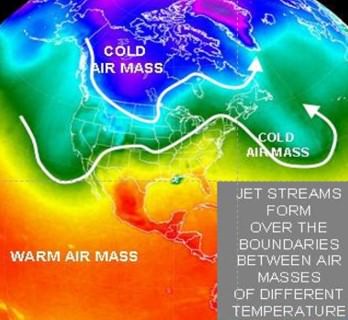
Circumpolar
- Jet streams are winds that circle around the earth with poles as their centers.
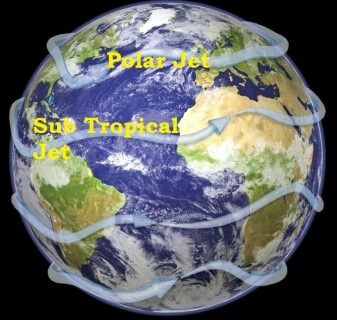
Narrow, concentrated bands
- The stream of air is very narrow (50 -150 km across) and, the air in the stream is directed towards the axis of the stream making it very narrow.
Meandering
- When the temperature contrast is maximum, jet stream flows in near straight path.
- But when temperature contrast reduces, the jet stream starts to follow a meandering path.
- So meandering depends on temperature contrast (temperature gradient).
- A meander is called peak or ridge if it is towards poles and trough if it is towards equator.
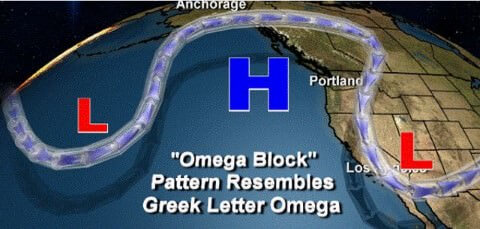
Rossby Waves
- The meandering jet streams are called Rossby Waves.
- Rossby waves are natural phenomenon in the atmosphere and oceans due to rotation of earth.
- In planetary atmospheres, they are due to the variation in the Coriolis effect (When temperature contrast is low, speed of jet stream is low, and Coriolis force is weak leading to meandering) with latitude.
- Rossby waves are formed when polar air moves toward the Equator while tropical air is moving poleward.
- The existence of these waves explains the low-pressure cells (cyclones) and high-pressure cells (anticyclones).
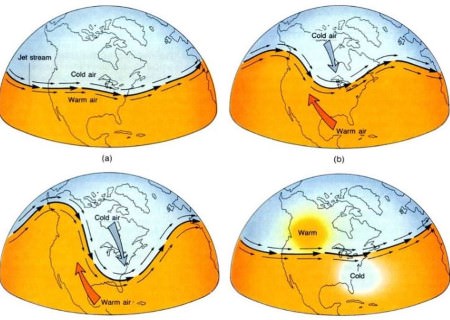
Upper Tropospheric
- Jet streams flow just below the Tropopause.
- Polar jet streams flow 6 – 9 km above the ground and Sub-tropical jet streams flows 10 – 16 km above the grounds.
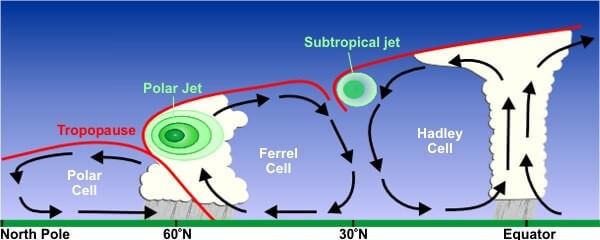
Why this difference in height?
- Recall that troposphere is thicker at equator –– 17 to 18 km, than at poles –– 8 to 9 km.
High velocity
- Pressure gradient increases with altitude and creates high velocity winds at higher altitudes.
- The friction in the upper troposphere is quite low due to less denser air. Hence the Jet streams flow at great velocities.
- Temperature also influences the velocity of the jet stream. The greater the difference in air temperature, the faster the jet stream, which can reach speeds of up to 250 mph (402 kph) or greater, but average about 110 mph (177 kph).
- The jet streams have an average velocity of 120 kilometres per hour in winter and 50 km per hour in summer. These jet streams also have cores where the speed is much greater.
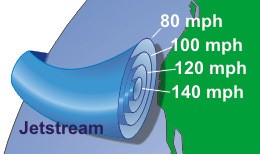
Geostrophic streams
- Direction of the jet stream is determined by pressure gradient force (temperature contrast creates pressure gradients) and Coriolis force.
- The direction of jet stream is perpendicular to the pressure gradient force.
Bounded by low speed winds
- The winds surrounding jet streams are of comparatively low velocities.
Are a part of upper level westerlies
- Jet streams are produced due to winds flowing from tropics towards poles (In polar jet streams wind flows from temperate region towards polar region, and in sub-polar jet streams winds flow from sub-tropics towards temperate region).
- Anything moving from tropics towards poles deflects towards their right in the northern hemisphere and towards their left in the southern hemisphere due to Coriolis effect. So jet streams flow from west to east in both the hemispheres and hence they are called westerlies or upper level westerlies.
- Jet streams when weak move in the direction of westerlies in a wavy, irregular manner with a poleward or equator ward component.
- Both the Northern and Southern hemispheres have jet streams, although the jet streams in the north are more forceful due greater temperature gradients.
Permanent jet streams
- There are two permanent jet streams – subtropical jets at lower latitudes and polar front jets at mid-latitudes.

Subtropical jet stream (STJ)
- The sub-tropical jet stream is produced by the earth’s rotation (Coriolis force) and temperature contrast between tropical and sub – tropical regions.
- At the equator, the rotation produces greatest velocity in the atmosphere.
- As a result, the rising air which spreads out northwards and southwards, moves faster than the latitudes over which it is blowing.
- It is deflected to the right in the northern hemisphere and to the left in the southern hemisphere, and at about 30° latitude, it becomes concentrated as the subtropical jet streams.
- During winter, the STJ is nearly continuous in both hemispheres. The STJ exists all year in the southern hemisphere. However, it is intermittent in the northern hemisphere during summer when it migrates north.
- The STJ can be temporarily displaced when strong mid-latitude troughs extend into subtropical latitudes. When these displacements occur, the subtropical jet can merge with the polar front jet (Related to Cloudbursts. We will study this in Indian Monsoons).
- STJ is closely connected to the Indian and African summer monsoons (We will study this in Indian Monsoons)
Polar front jet (PFJ)
- The polar front jet is produced by a temperature difference and is closely related to the polar front (more about fronts later).
- It has a more variable position than the sub-tropical jet. In summer, its position shifts towards the poles and in winter towards the equator.
- The jet is strong and continuous in winter.
- It greatly influences climates of regions lying close to 60 degree latitude.
- It determines the path and speed and intensity of temperate cyclones.
Temporary jet streams
- While the polar and subtropical jet streams are the best known and most studied, other jet streams can form when wind speeds are above 94 kph in the upper atmosphere at about 9 – 14.5 km above the surface.
- They are few. Important ones are Somali Jet and The African Easterly jet.
The Tropical Easterly Jet or African Easterly Jet
- There are also major high velocity winds in the lower troposphere called low-level jets (LLJs). In the tropics, the most prominent of these are the Somali Jet and the African Easterly Jet.
- The TEJ is a unique and dominant feature of the northern hemispheric summer over southern Asia and northern Africa. The TEJ is found near between 5° and 20°N.
- It is fairly persistent in its position, direction, and intensity from June through the beginning of October.
- During the south Asian summer monsoon, the TEJ induces secondary circulations that enhance convection over South India and nearby ocean.
- The establishment and maintenance of the TEJ is not fully understood but it is believed that the jet may be caused by the uniquely high temperatures and heights over the Tibetan Plateau during summer.
- The TEJ is the upper-level venting system for the strong southwest monsoon.
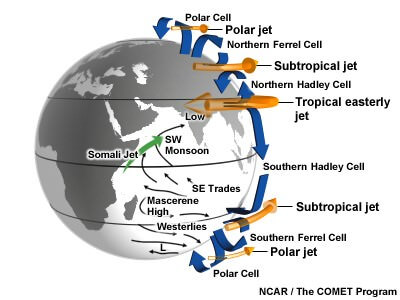
The Somali Jet
- Among the most well-known of the tropical LLJs is the Somali Jet, a southwesterly
- The Somali jet occurs during the summer over northern Madagascar and off the coast of Somalia. The jet is most intense from June to August.
- It is a major cross-equatorial flow from the southern Indian Ocean to the central Arabian Sea.
- A split in the axis of the jet over the Arabian Sea, the more northern branch intersecting the west coast of India near 17°N, while the southerly branch moves eastward just south of India.
- The jet remains relatively steady from June to September before moving southward to the southern Indian Ocean during the winter.
Influence of Jet Streams on Weather
- Jet streams help in maintenance of latitudinal heat balance by mass exchange of air.
- PFJ influence the mid-latitude weather disturbances. Usually there are severe storms when jet streams interfere with surface wind systems.
- Jet streams also influence the path of temperate cyclones. They have an influence on distribution of precipitation by the temperate cyclones.
- Sub-tropical jet stream and some temporary jet streams together influence Indian Monsoon patterns. (more about this while studying India Monsoons in Indian geography)
- Jet streams also exercise an influence on movement of air masses which may cause prolonged drought or flood conditions.
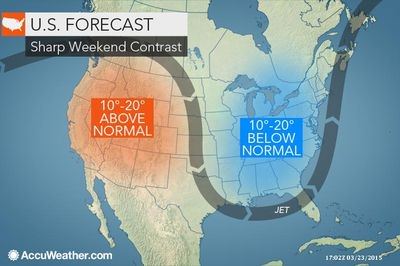
Jet Streams and Weather in Temperate Regions
How does jet streams affect the weather in temperate regions?
- PFJ play a key role in determining the weather because they usually separate colder air and warmer air.
- Jet streams generally push air masses around, moving weather systems to new areas and even causing them to stall if they have moved too far away.
- PFJ play a major role in determining the path and intensity of frontal precipitation and frontal cyclones or temperate cyclones.
- Weak PFJ also results in slipping of polar vortex into temperate regions. (More later)
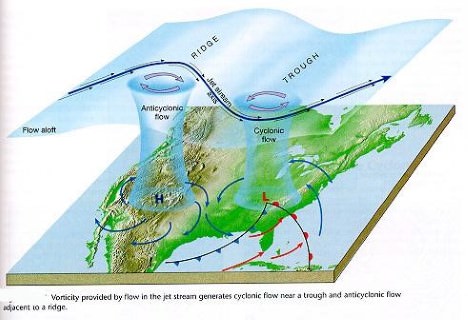
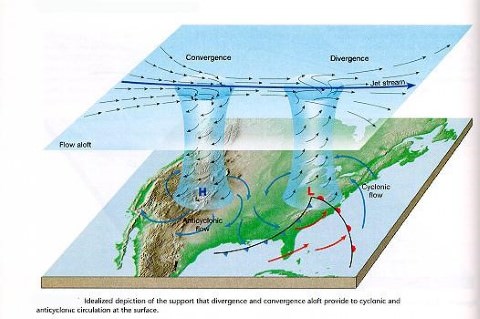
Explanation
- Polar jet has distinct peaks (ridges) and troughs.
- Ridges occur where the warm air (at high pressure) pushes against the cold air.
- Troughs occur where cold air (at lower pressure) drops into warm air.
- This condition occurs due to weak jet stream which is weak due to lesser temperature contrast between sub-tropics and temperate region.
- These ridges and troughs give rise to jet streaks which are the main reason behind cyclonic and anticyclonic weather conditions at the surface.
- The winds leaving the jet streak are rapidly diverging, creating a lower pressure at the upper level (Tropopause) in the atmosphere. The air below rapidly replaces the upper outflowing winds. This in turn creates the low pressure at the surface. This surface low pressure creates conditions where the surrounding surface winds rush inwards. The Coriolis effect creates the cyclonic rotation that is associated with depressions.
- The winds entering the jet streak are rapidly converging, creating a high pressure at the upper level (Tropopause) in the atmosphere. This convergence at upper troposphere leads to divergence (high pressure) at the surface (anticyclonic condition).
- The Coriolis effect creates the anticyclonic rotation that is associated with clear weather.
Jet Streams and Aviation
- Jet streams are used by aviators if they have to fly in the direction of the flow of the jet streams, and avoid them when flying in opposite direction.
- Jet streams can also cause a bumpy flight, because the jet stream is sometimes unpredictable and can cause sudden movement, even when the weather looks calm and clear.
- During volcanic eruptions plumes of volcanic ash have a tendency to get sucked into the same jet stream that airplanes use for travel.
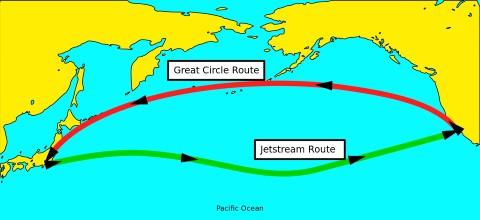
Jet streams on other planets
- Other planets have jet streams as well, notably Jupiter and Saturn.


No comments:
Post a Comment